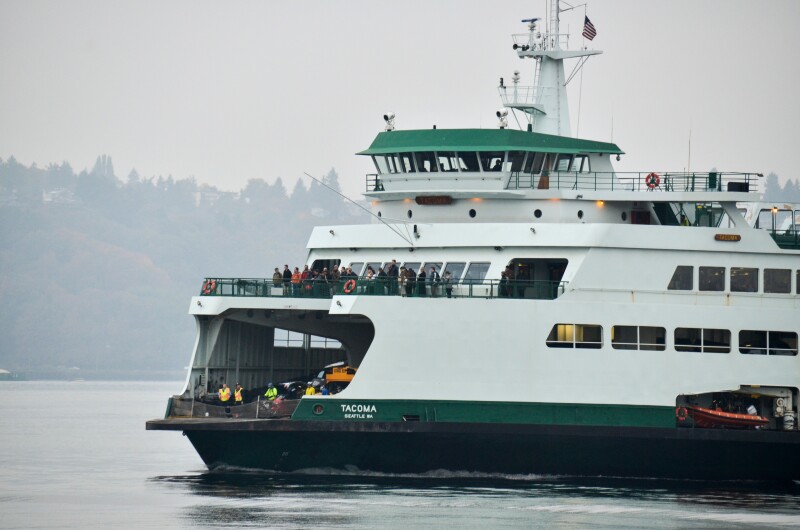I just realized that WSF is awfully close to WTF, which is what many Puget Sound ferry riders have said about Washington State Ferries’ service over the past several years. But, to be fair, service has improved, and state officials are promising a nearly full summer schedule of boats and crews.
The Wenatchee, one of WSF’s largest boats, a Jumbo Mark II-class ferry, is expected to return to service after spending about two years in Vigor’s Seattle shipyard, where it has been converted from mechanical-diesel to hybrid diesel-battery propulsion. The Wenatchee was supposed to be completed in a year and to use about half the money allocated for two Jumbo conversions. However, the extra year also ate up all the budget and most of the available patience, so the plan now is to skip the second conversion and concentrate on getting five newbuild hybrid ferries ASAP. A final request for bids was sent out earlier this year.
Three shipyards had been expected to bid on a contract for up to five boats. Only two did: Eastern Shipbuilding Group, Panama City, Fla., and Nichols Brothers Boat Builders, Freeland, Wash. When the bids were opened in early May, Eastern's bid was about 25% lower than Nichols'. Getting a lower bid from the Gulf wasn’t unexpected, and Washington State bidders were granted extra leeway to account for higher labor and regulatory costs.
Not surprisingly, many Washingtonians are advocating for Nichols Brothers because the contract money would have an economic ripple effect and help the state invigorate its shipyard industry. On the other hand, obtaining the boats for less money would benefit taxpayers who are footing the bill.
Eastern has experience building large double-enders for New York’s Staten Island Ferry, which it delivered a few years ago — reportedly on time and on budget. Nichols has built the superstructure for WSF’s most recent newbuilds, the Olympic class, but hasn’t constructed the complete package. The company’s Whidbey Island yard is also handicapped with only beach-launching capability. Its sister shipyard, Everett Ship Repair, is nearby with two large drydocks and plenty of shoreside space. With the new hybrids to be larger than the Olympic-class (160 cars capacity compared to 144 cars), Everett would likely take on a large portion of the construction.
Gavin Higgins, Nichols’ CEO, has suggested publicly that the contract be split between Eastern and Nichols. His yard may be more expensive initially, but it wouldn’t require a long delivery voyage through the Panama Canal, nor would it be vulnerable to Gulf Coast hurricanes, he said.
Washington’s new governor, Bob Ferguson, is said to be mulling the options.
This is the first time that WSF has looked out of state for a shipyard to build new boats. Until now, it was precluded from doing so by law, which was changed a couple of years ago.
The idea of splitting the contract is appealing. The state’s ferry riders could get new boats more quickly and for less money, with Eastern building a pair while Washington’s commercial marine industry would be able to work more closely with WSF managers and enable a new generation of vendors and builders. Seattle-based Elliott Bay Design Group has designed the new boats.
Back in the 1980s, when Seattle-based companies were building new factory trawlers, some of the boats were built in the Gulf at Bender Shipbuilding & Repair Co., Mobile, Ala., and some were built in Washington by Dakota Creek Industries, Anacortes, and J. M. Martinac Shipbuilding Corp., Tacoma. After a year or two of operation, it was apparent that the Gulf boats, while initially less costly, weren’t as well-built and suffered from more downtime than the Washington vessels. The reputation wasn’t great.
Now, quality construction from Eastern hasn’t been an issue, as far as I know. If anything, it’s been a model of successful ship construction for decades. I’m fairly certain the company can make good on a commitment to build what Washington ferry riders need.
What had originally been five new hybrid ferries has now become four, with each of the two competing shipyards building two. The Washington legislature has allocated about $1.3 billion for five, including shoreside infrastructure. That number is now seen as overly optimistic. “I don’t see how you get to five,” said State House Transportation Committee Chair Jake Fey, D-Tacoma. “There’s money for three on a good day,” he told the Washington State Standard.
State Republicans, the minority in the Legislature, have advocated for new mechanical-diesel ferries. WSF has countered that this would mean the loss of funding from the state’s Climate Commitment Act and require more redesign work. That option could set back delivery of new boats by about two years.
WSF isn’t required to accept only the lowest bid. It could split it if it wanted to. Personally, I think splitting the baby would be best. That way, as a ferry rider myself, I’ll get four boats in the time it takes to build two at just one yard. Well, maybe. Probably not, but you never know until you try. Splitting would be important for the local economy, including Whidbey Island, where I live, and where Nichols has its shipyard. It would keep some of the state money here in Washington.
An announcement of WSF’s decision is expected any day now. I hope I don’t say WTF.




